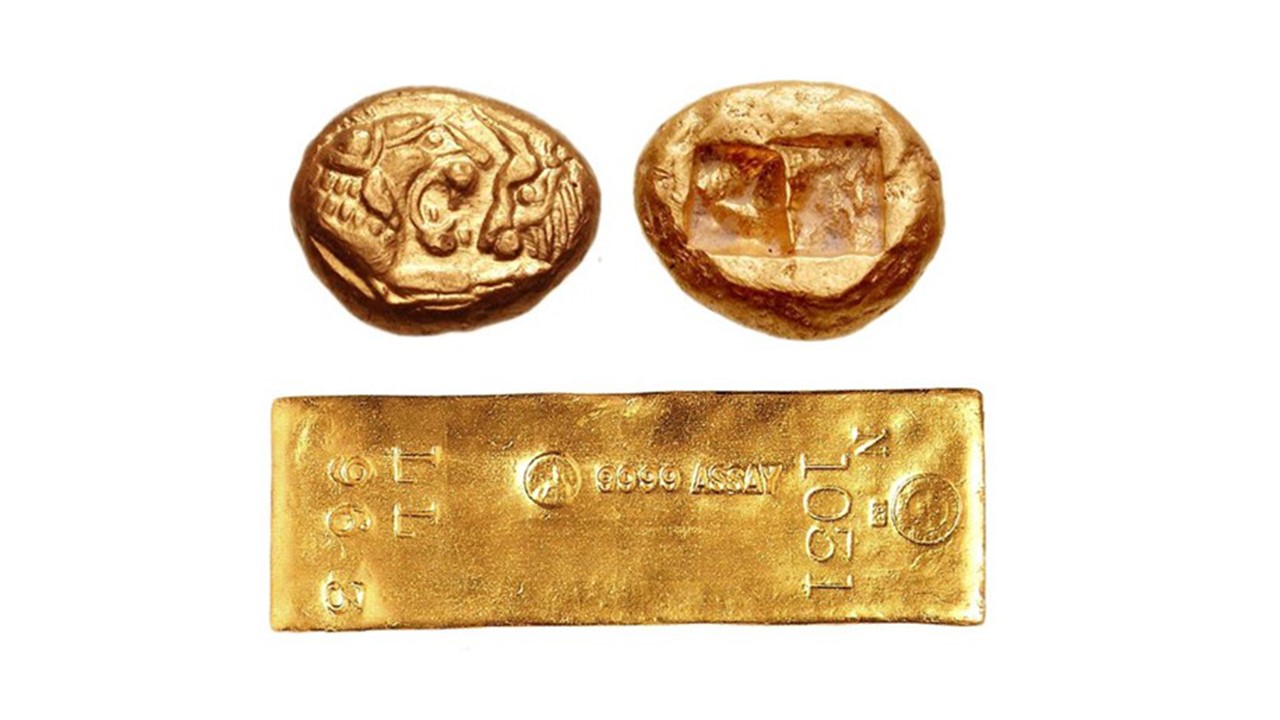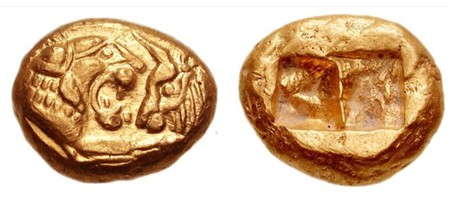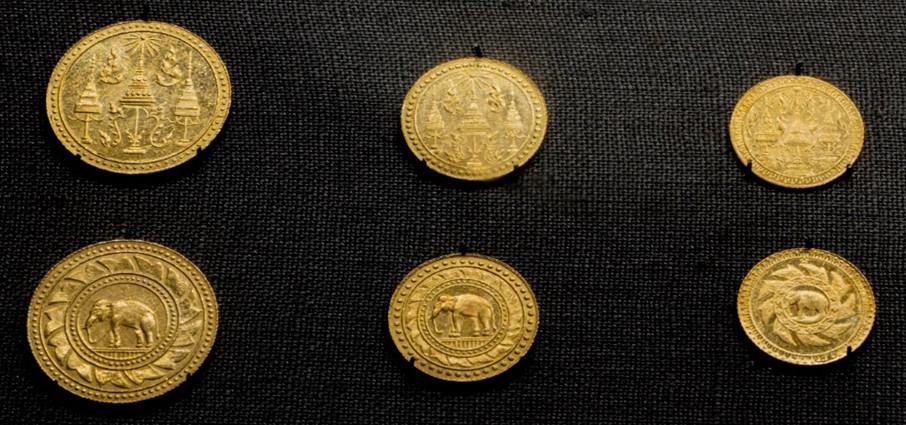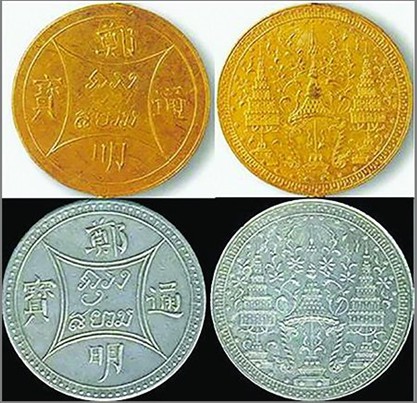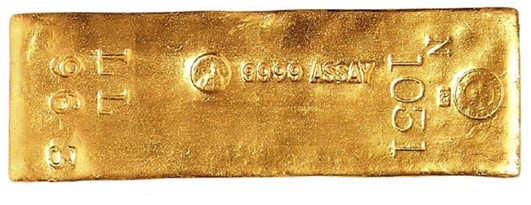Gold is a chemical element with the atomic number 79 and the symbol Au (from Latin aurum). It is one of the rarest elements with the higher atomic number in the world that occurs naturally. Gold is a transition metal. It is golden in color and soft to touch. Also, gold has other qualities that increase its value, for example, its bright, shiny, and beautiful surface, along with its high malleability and ductility. Gold does not react to most chemicals and is more resistant to erosion when compared to other elements. Moreover, when exposed to air, gold does not lose its shine or develop rust. It keeps well in normal environment.These characteristics have made gold valuable and desirable since ancient times.
Humans could make use of gold without the need to purify or use special machinations. It has been used as decorations in religious ceremonies, royal decorations, a medium of exchange in place of money and as money itself. Therefore, from past to present, it is clear that gold is highly valued and highly accepted. Even now, gold is still used as national reserves, as jewelry, in dentistry, and in electronics, for example as a connector.
Pic 1: Periodic Table
Source: https://www.ptable.com/?lang=th
The Origin of Gold
There are two types of sources in nature where gold ores are found: primary and secondary gold sources. Primary gold refer to gold that is embedded in rock minerals or as veins running through other kinds of stone. Secondary gold or placer gold refers to when primary gold are eroded by weather, washed away, thus accumulate somewhere else, for example in valleys, streams, or in rocks and grains on river beds. Most gold on earth is found as veins in other stones. The formation of gold occurs in hot hydrothermal fluids of magmatic origins which penetrates through cracks of rocks, and eventually solidifies after it cools down. Scientists call metals which form through this type of formation porphyry deposits. Because it is difficult for oxidization to occur, pure metal can be found preserved in the host rock. Mining is a common mean of extracting gold in world gold industry. To achieve an ounce or 31.104 grams of gold, 100,000 ounces of ore is needed.
There are several major gold deposits around the world, for example in Europe, Asia, Australia, Africa, South America, Mexico, Canada, and the United States of America. There has been a constant increase in world gold production, rising from 39 million ounces in 1980 to 46 million ounces in 1984. In Thailand, our sources for primary gold are Tomo mine in Narathiwat province, Khao Samsib deposit in Sa Kaeo province, Chatri mine (Khao Pong) covering areas from Phichit province to Phetchabun province, Doi Tung deposit (Ban Pha Hee) in Chiang Rai province, and Khao Phanompha deposit in Phichit province. Secondary gold deposits include Ban Paron in Prachuab Kiri Khan, Ban Na Lom in Prachinburi, Ban Tunghua in Lampang, deposits around Mekong area starting from Loei province to Nongkhai, and Ban Pha Changmoob in Payao province.
Gold in World Monetary System
Humans have been using precious metals such as gold, silver, and copper as currencies since the time of ancient Egypt. Thus, these types of metals are categorized as coinage metals. There was evidence suggesting productions of gold coins 2,700 ago by people of Lydia, the kingdom situated in modern day Turkey. The Lydians divided natural alloy of silver and gold into small pieces according to official weight standards. Each piece was stamped with the king’s royal emblem as a guarantee for its weight, as well as its legitimacy to be used as legal tender. From this procedure, value of money was standardized. These metal pieces which had been marked hence had been given a particular price to it is called ‘currency’ or Ngern Tra(marked silver/stamped money) in Thai. after having used silver and gold alloy coinage for 50 years, the Lydians learned to successfully extract gold from silver, and started producing gold and silver coins for circulation.
Pic 2: Lydian Coin
Source: https://colnect.com/th/coins/
Gold in Thai Monetary System
Historical evidence suggests the use of gold in Thai trading system had been present since Dvaravati period, or around 5th Century CE. Flat, round silver and gold coins were found in various sizes. Gold trade was mentioned on the first stone inscription of Sukhothai period which gives us information about the use of gold during that time. Later during the prosperous years of Ayutthaya, gold was widely used for making art. In the reign of King Narai, when relations between Siam and France were being pursued, there were mentions of gold deposits in Thailand. Additionally, according to a chronicle, King Borommakot ordered a gold-panning program. All evidence points towards the abundance of gold in Thailand.
During 1350-1767 AD, the provinces which were under the rule of Ayutthaya kingdom but were located further away from the capital were allowed to produce currency for local use. Pattani which was one of the twelve satellite states (according to Chinese zodiac) under Nakhon Si Thammarat was also found to have produced gold coins for local use. The coins were imprinted with a zodiacal ox sign which was symbol of the city, along with Matahari sign and Arabian characters.
Pic 3: Gold Pattani Coin
During 1847-1861 AD, there was a gold rush in the United States, Canada, Russia, South Africa, and Australia. As a result, the volume of gold found reached its highest in three decades and made the United States the biggest gold producer in the world. The market price of gold increased 7-8 times than previously. In the meantime, the kingdom of Siam started to initiate free market system with foreign counterparts. With that came a significant amount of gold flowing into Thai market. Having spotted the overflow of gold, King Mongkut commissioned the production of gold coins in order to put them in circulation. However, the King did not wish that gold in domestic production be made into gold alloy as British gold coins. Thus, no copper was mixed into Thai gold coins. According to traditional Thai monetary system which aligned the value of money with its material, these gold coins as currency are called Gnern Tem Kha or full-valued money.[1]
The First Gold Coin of Rattanakosin
In 1863, King Mongkut commissioned the first production of gold coins in three denominations, called Tod, Pit, Phadduengse, and allowed them into circulation. They could be used as legal tender, to trade with foreigners alongside silver coins that had already been in circulation. The coins were flat and round and had a gear edge. On the obverse of Thong (gold) Tod and thong Pit coins, there was an image of the crown and shining rays, flanked by two royal umbrellas. The rim of the coin was decorated with a dotted line. On the other hands, on Phadduengse coins, there was a Kranok pattern both outside and inside the umbrella design. The rim of the coin was decorated with a flower pollen design according to Thai tradition art. On the reverse, there was an image of a Chakra with an elephant in the center, surrounded by the same pollen design on the rim like on the obverse.
Tod gold coins (Thong Tod) refer to a large type of gold coins (22 millimeters) which has the value of 8 baht/ticals or 2 tamleung/taels. Tod in ancient Thai means ten, indicating that 1 tod gold coin equals 1/10 of one chang /catty, and 10 tod coins equals one chang.
Pit gold coins refer to a middle type of gold coins (17 millimeters) which has the value of 4 baht/ticals or 1 tamleung/taels. Pit in ancient Thai means twenty, indicating that 1 pit gold coin equals 1/20 of one chang /catty, and 20 pit coins equals one chang.
Phadduengse gold coins refer to a small type of gold coins (16 millimeters) which has the value of 2.5 baht/ticals or 10 salueng/taels. Phadduengse in ancient Thai means thirty-two, indicating that 1 phadduengse gold coin equals 1/32 of one chang/catty, and 32 pit coins equals one chang.
Pic 4: Tod Pit Phadduengse Gold Coins
The first production of commemorative coins in Thailand occurred around the same time. When King Mongkut was to celebrate His Majesty’s 60th birthday in 1864, the King commissioned the production of a set of silver and gold coinage called Tae Meng Tong Bo. It had the value of 4 baht and the weight of 60 grams which corresponded to the age number of the King. The denomination of the coin is indicated by the image of stars on the obverse and along the rim of the coins. The coins are round, flat, measuring 45 millimeters in diameter, and have a flat rim. The obverse side depicts the emblem of the royal crown with shining rays, and a royal umbrella on both sides. On the field of the coins is decorated with a botanical design. Along the rim is a design of 32 stars, referring to the value of 32 fueang, which equals 4 baht or 1 tamlueng. On the outermost of the rim is decorated with a pollen design. On the reverse side, there is a large Keaw Ching Duang or Thai honeycomb design with a text in the center which reads ‘Kyung Siam’ in Thai. There are four Chinese characters placed in four directions around the main design. These Chinese characters are read in Taochew dialect as ‘tae meng tong bo’, meaning Tae Meng’s treasures. Tae meng is King Rama IV’s royal initials in Chinese. It thus became the poplar name of this type of coins, namely ‘Tae Meng coins’.
Tae Meng coins have several unique characteristics. One is that the King allowed the coins to be used as a royal decoration; the other is that the coins could also be used a legal tender because there was a symbol on the coins indicating their denomination. However, since the production numbers were remarkably small, the coins later gained popularity as collectibles instead.
Pic 5: Gold and Silver Tae Meng Coins
Source: https://www.khaosod.co.th/amulets/news_728791
Setting Gold Standards in Thai Monetary System
During the reign of King Rama IV or King Mongkut, gold prices in Thailand was tied to silver standards as had previously been since ancient times. Gold prices were categorised, given names and denominations. Each piece of gold had different texture(neua) or weight(nam) of gold. This was a tradition observed by the people in ancient city of Chiang Saen. Chiang Saen people measured gold by weight and finesse. Pure gold which had not been alloyed with other metals was called gold with ninth-grade texture (Thong Neua Kao) or gold which weighs nine (Noppakhun Kao Nam). Gold with less finesse was called differently according to the degree of purity, namely eighth-, seventh-, and sixth-grade-textured gold. Gold with a lowest degree of purity is called gold with a fourth-grade texture (Thong Neua Si). This type of gold was sold for 4 baht (unit of currency) per 1 baht (unit of mass). Gold with a nineth-grade texture (Thong Neua Gao) was priced the highest, namely at 9 baht (unit of currency) per 1 baht (unit of mass). As for the transaction where the value of gold exceeded one baht, the excess amount was called leg (Kha). For example, one sixth-grade textured gold and two legs means a piece of gold which weighs one baht is sold for six baht and two saleung.
Later during the reign of King Chulalongkorn, there had been great development in international trade. However, the production of gold coins in this period was still aligned with silver standards. Thus, for greater internationalization of trade, in 1908 the King ordered the realignment of Thai monetary system with gold standards, which had already been adopted by Thailand’s foreign counterparts. The King enacted the Gold Standard Act to standardize the value of Thai baht against fine gold. From then on, gold became a part of Thailand’s currency reserve, and has been used by the government to back the printing of banknotes. Gold bars for this purpose weigh approximately 15 kilograms each. Most countries worldwide usually invest in gold bars with 99.99% purity or 24 Karats, while in Thailand gold bars with 96.5% purity or 23 Karat gold are preferred.
Pic 6: Gold Bar
As the world’s rarest natural ore, along with its special characteristics, i.e. its endurability and timeless beauty, gold has long been accepted as a precious metal and has been used as a medium of exchange worldwide. From past to present, human beings have been able to make wide-ranging use of gold. Due to its chemical and physical features, gold has been used generally to make jewelry, religious artifacts, in architecture, electronics, as well as in dentistry. Most significantly is the history of gold as a medium of exchange or as a currency. The minting of gold coins as well as the use of gold in currency reserves continue until the present day. It can be said that gold is in itself a currency or a good representation of currency, no matter what forms it takes or in which period it is used. What is more, its price also seems to be ever increasing.
[1]Due to its malleability, gold can erode thus loses its mass after a long use whether as currency or as jewelry alike. In order to increase durability and extend the lifespan of the coins, many European countries added other kinds of metals which were harder but lower in value than gold to the mix, for example copper. Not entirely being made of gold, the metal value of European alloyed gold coins were less than the nominal value indicated on the coins. The metal used as the material of the coins was called ‘money with lesser value’ or Ngern On Kha. (Nawarat Lekhakul, Bia Baht Kasap Bank, Bangkok: Bangkok Printing Press (1984, 2542)
